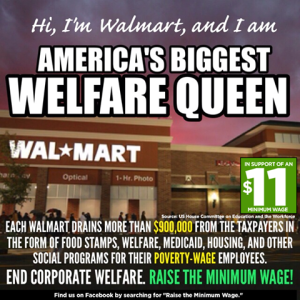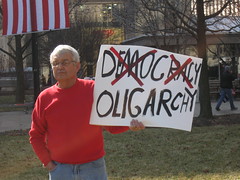

Some label Walmart and McDonald’s as “Welfare Queens.” The reasoning goes that due to the low wages and paltry benefits paid by these companies, their employees rely on public assistance to make ends meet. This taxpayer funded assistance would not be needed if the companies paid better. Therefore, the cost of the assistance amounts to welfare for the corporations.
The problem with this reasoning is that assistance paid to the employees benefits the employees, not the employer. Theoretically, they are actually a cost to the employer because they raise the reservation wage (the lowest wage for which a person will work), but this effect is obscured by the minimum wage (which is higher than the reservation wage).
A place where true corporate welfare can be seen is agribusiness. Federal crop subsidies overseen by the Department of Agriculture flow directly into the coffers of the largest farming companies.
Corporate Welfare and Crony Capitalism
Corporate Welfare and Crony Capitalism both refer to corporate entities receiving unearned subsidies.
Corporate Welfare is the more intuitive term. Slivinski (Cato Institute) states, “‘corporate welfare’ is defined as any federal spending program that provides payments or unique benefits and advantages to specific companies or industries.” Sinn (Think by Numbers) offers a similar definition, then clarifies that an expenditure is only welfare if the government does not receive goods or services in exchange. Mattera (Good Jobs First) expands the definition from federal spending to include state and local spending as well.
Crony Capitalism focuses on lobbying for special favors. The technical term for this is rent seeking behavior. Johnson (Auburn University) offers this definition:
The expenditure of resources in order to bring about an uncompensated transfer of goods or services from another person or persons to one’s self as the result of a ‘favorable’ decision on some public policy…
Examples of rent-seeking behavior would include all of the various ways by which individuals or groups lobby government for taxing, spending and regulatory policies that confer financial benefits or other special advantages upon them at the expense of the taxpayers or of consumers or of other groups or individuals with which the beneficiaries may be in economic competition.
Investopedia notes: “These (rent-seeking) activities don’t create any benefit for society, they just redistribute resources from the taxpayers to the special-interest group.” Henderson (Concise Encyclopedia of Economics) reinforces that while rational from the narrow viewpoint of the rent-seeker, rent-seeking activities are pure loss to the economy as a whole.
There is substantial overlap in these definitions of corporate welfare and crony capitalism, as both cover the broad concept of the government transferring money or other advantages to corporations. To clarify the differences, consider senior citizens lobbying for increased Social Security benefits. This fits the definition of crony capitalism, but not corporate welfare because senior citizens are not a corporation. In contrast, a licensed electrician enjoys reduced competition created by a stricture on unlicensed electrical work. This is a form of corporate welfare, but not crony capitalism because the electrician did not personally lobby for the regulation.
Introducing the Welfare Queens

According to Blake (CNN) , the earliest known use of the term “Welfare Queen” was by a Chicago newspaper in 1974. The lady it referred to, known as Linda Tayler among other names, plus two ladies in Los Angeles, formed the basis for candidate Ronald Reagan’s famous 1976 story:
There’s a woman in Chicago. … She has 80 names, 30 addresses, 12 Social Security cards. … She’s got Medicaid, getting food stamps and she is collecting welfare under each of her names. Her tax-free cash income alone is over $150,000 (over $600,000 today).
This slightly embroidered story of fraud in the social welfare arena resonated with white, working class voters, and over time it took on a life of its own. Eventually, President Clinton and a Republican-controlled congress ended welfare as it was known in 1996, but the myth of the Welfare Queen lived on. Today it has jumped from the social realm to the corporate realm, and companies receiving corporate welfare are pilloried as Welfare Queens.
Walmart and McDonald’s
“Walmart,” according to Americans for Tax Fairness (ATF), “is the largest private employer in the United States, with 1.4 million employees. The company, which is number one on the Fortune 500 in 2013 and number two on the Global 500, had $16 billion in profits last year (2013) on revenues of $473 billion.” Ritholz (Bloomberg View) provides a comparable synopsis.
In April 2014, ATF published a well-publicized report entitled “Walmart on Tax Day.” The report found “Walmart and the Walton family receive tax breaks and taxpayer subsidies estimated at more than $7.8 billion a year.” Specifically:
- Walmart receives an estimated $6.2 billion annually in mostly federal taxpayer subsidies. The source is employees receiving public assistance due to low wages and poor/non-existent benefits.
- Walmart avoids an estimated $1 billion in federal taxes each year through the use of accelerated depreciation.
- The Waltons avoid an estimated $607 million in federal taxes on their Walmart dividends because dividends are taxed at a lower rate than ordinary income.
Worstall (Forbes) calls the ATF report “fantastical nonsense,” and answers point for point.
- Except for the Earned Income Tax Credit (EITC), all assistance received by Walmart employees are benefits to the employees, not the company. In fact, they are a cost to the company because they raise the reservation wage.
- The use of accelerated depreciation is a matter of tax law. Walmart is merely doing what the IRS tells them to do.
- In the US, dividends are taxed twice, once as corporate profits and again as income. The combined rate is actually higher than the rate on ordinary income.
The first point goes to Worstall. ATF reflects the popular view that public assistance paid to employees is a corporate subsidy. Worstall counters, consistent with the definition of Corporate Welfare above, that benefits paid to employees are not subsidies to the employer. Only benefits paid to the employer can be counted as corporate welfare.
The second point is split. Worstall is correct in pointing out accelerated depreciation is what the tax code dictates. However, The Committee for a Responsible Federal Budget recognizes accelerated depreciation, which is intended to encourage investment, as the largest corporate tax break in the tax code. Since it is an advantage that Congress can give or take away, ATF are correct to include it in their analysis as a type of corporate welfare.
On the third point, Worstall is correct. The dividend income should not be considered a Walton family benefit. However, the double taxation on dividends, like accelerated depreciation, is a matter of Congressional dictate. Since current policy does not favor a special-interest group, but rather is a penalty, it does not meet the definition of corporate welfare. However, this situation could change following an act of Congress in the future.
The essence of McDonald’s story is very similar to Walmart’s. McDonald’s is often held up beside Walmart as the second corporate Welfare Queen. According to the National Employment Law Project (NELP), low wages and lack of benefits at McDonald’s are estimated to cost taxpayers $1.2 billion per year. Again, most of this money is paid to McDonald’s employees, so it is not a subsidy to the corporation.
The popular notion of Walmart and McDonald’s receiving corporate welfare as a result of their low wage and low/no benefit policies does not hold water, but this does not mean the companies are exonerated. Walmart, for example, acts as a monopsonist (a sole buyer, like a monopolist is a sole seller) in the wholesale and labor markets, and thus can dictate terms. There is also the question of anti-union activities and allegations of sexism. These issues will have to be the subject of another essay.
Agribusiness

Corporate farms are not popularly portrayed as Welfare Queens, but, according to Sinn, they received about 40% of federal corporate welfare.
Federal crop subsidies fund the wealthiest farmers. As Sinn observes, corporate welfare works opposite of social welfare. In the social sphere, the less you have, the more you get. In the corporate sphere, the more you have, the more you get. Slivinski (p. 7) (Cato) found the richest 10 percent of subsidy recipients received 66 percent of subsidies in 2005. Instead of aiding small family farms, the subsidies help large industrial operations shut them out of the market.
The true Welfare Queens, then, are companies you may never have heard of: Riceland Foods, Inc, Producers Rice Mill, Inc, Farmers Rice Coop, etc. (per EWG).
Conclusion
The popular portrayal of Walmart and McDonald’s as corporate Welfare Queens is false. It is true that because these companies pay low wages and minimal benefits many of their employees rely on various forms of public assistance. It is not true that the assistance paid to the employees is welfare to the employers. The assistance would have to be paid to the employer for that to be the case.
Even if they are not receiving corporate welfare from paying low wages, their behavior in the labor market is highly suspect. This is the subject for another essay.
Valid examples of corporate welfare can be found in farming. The Department of Agriculture distributes federal crop subsidies in such a way that the richest corporate farming operations receive the most benefits.
Afterword
Some of the conclusions I draw in this article are the opposite of my assumptions going in. Do you agree with my conclusions? Do you think I am off base? I am interested to read your response. Please leave a comment. Thanks! SFJ



